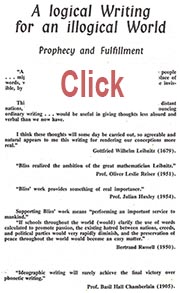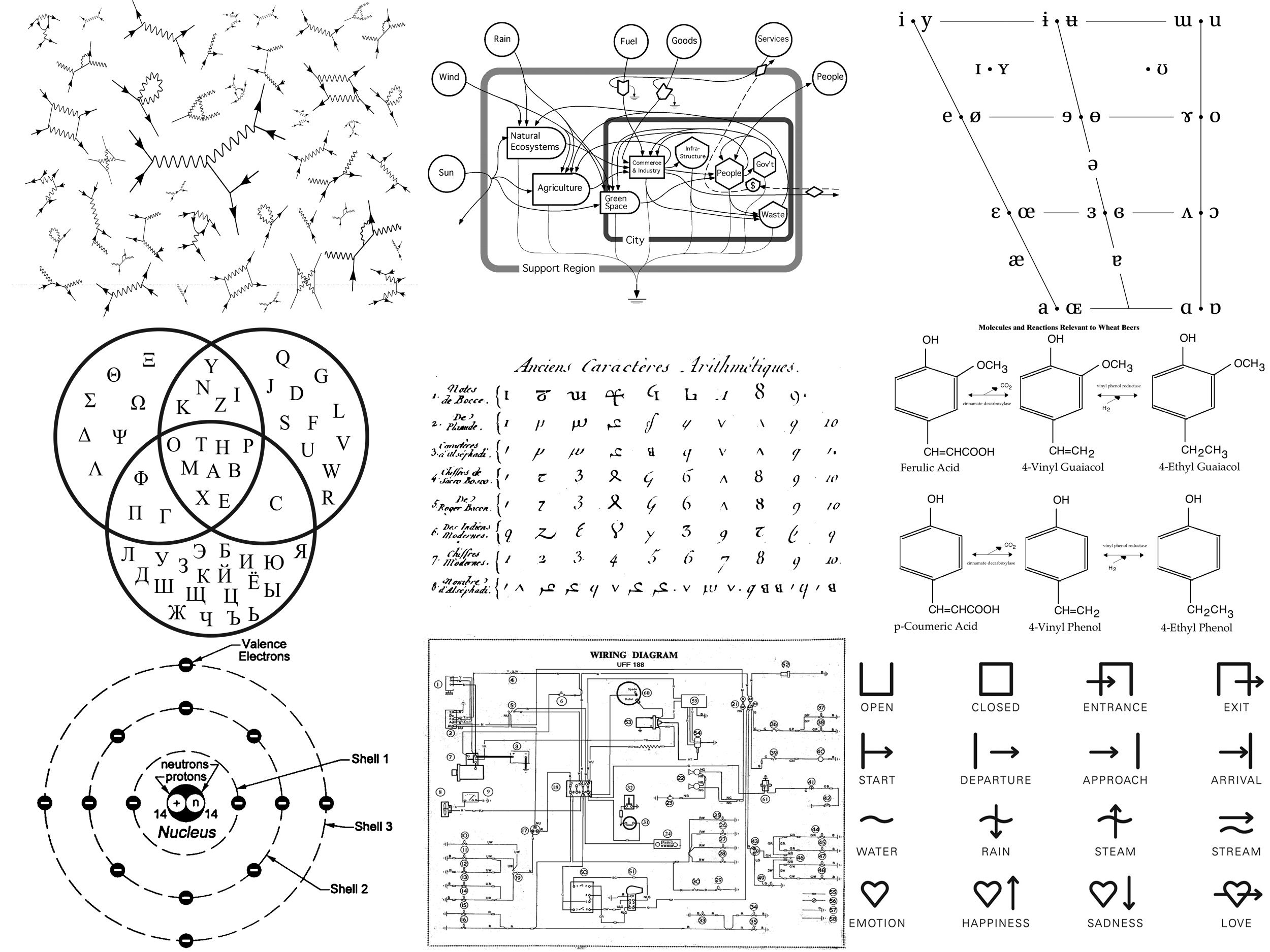
THURSDAY, DEC 31, 2015

Symbolics
For literacy, numeracy, and ecolacy
Eric Lee, A-SOCIATED PRESS
TOPICS: DIAGRAMMATIC LANGUAGE, FROM THE WIRES, CHARACTER SETS, COMMUNICATION, SHARED LANGUAGES
Abstract: Symbols are alternative to words, words, words, which are easily obfuscated and controverted. Symbols can be indipendent of the seven thousand or so spoken languages and hence more universal. A pictographic written language could be a universal language for universal literacy. Various symbol systems together could allow for universal diagrammatic thought to help humans to endeavor to think well..
TUCSON (A-P) — To "prepare information packages for the contingency of restart after crashing" implies the use of language. A universal Babel fish translator could translate information into the major spoken languages in use, but if such technology also crashes or the languages themselves are inadequate to communicate the information, we need to rethink what is needed. The dominant language, the lingua franca, has been the language of expediency at differing times and places: Greek, Latin, French, Hindi, Portuguese, Spanish, Russian, Arabic, Chinese, Urdu, Indonesian, Swahili, and in the 21st century English, the first global lingua. Given the current growth pulse in China, the next one could be Chinese, or if the Global Caliphate comes, Arabic could become the global lingua. The pattern is one of dominance, socio-political hegemony, wherein the passing of one empire necessitates a changing of the language guard.
If a sustainable empire of some sort is possible, should the global lingua just be the last dominate language in use? The problem of too many spoken languages, the embarrassment of riches that inconveniently prevents even rudimentary global communication, may not be one of creating a spoken language that everyone learns. There are about 6,500 spoken languages, and perhaps none qualify as potentially universal because all natural languages are primarily spoken, using from 11 to 141 speech sounds (English uses 44) with no one sound used by all languages. Languages for conversation are marginally conceptual in any rigorous sense, and come with built-in (evolved-in) cognitive limitations that serve socio-political ends that include deception of self and others.

Doing advanced mathematics using any natural language, whether English or Swahili, with no mathematical symbols would be likely impossible as it has never been done. Leibniz's guess that a conceptual language, a sort of logical, semantic, extended mathematical language, using visual ideograms to diagram clearly definable ideas is needed for advanced thought, may be the starting point for defining what is needed. We don't have to speak the same language other than for rudimentary utilitarian reasons, especially if spoken language, good enough for social interaction, is too conceptually limited. We need to think clear thoughts which all spoken natural or constructed languages may impede as they fail to provide the needed "alphabet of human thought" as Leibniz and others since have perceived the need for.
The characteristica universalis of Leibniz was conceived as a universal pictographic language for all forms of science and scholarship to use, as beyond a certain point advanced cogent thinking depends upon it. As an ideographic language, like written Classical Chinese, spoken words associated with the symbols could vary just as what you call "1, 2, 3, 4, 5,..." doesn't matter. Speakers of Japanese, Cantonese, Mandarin, Korean, etc. can read the same ideographic language. Learning to read Chinese, however, involves a broad and steep learning curve, but learning a universal pictographic/ideographic constructed written language could be much easier than learning a spoken language and would be alternative to learning the current lingua franca or a constructed spoken language like Esperanto (there have so far been about 60 constructed languages intended to be auxiliary universal languages: e.g. Solresol, Volapük, Esperanto, Ido, Latino sine flexione, Interlingue, Interlingua, Kotava, aUI, Lingua Franca Nova, Toki Pona, Lojban, Ithkuil).
 Leibniz failed to develop his concept into an actual language, but in the 20th century Charles K. Bliss made a credible effort by developing Blissymbolics conceived as a universal ideographic writing system originally called Semantography (Blissymbolics): A Logical Writing for an Illogical World, but so far it has found use mainly by therapists endeavoring to treat those with severe speech disabilities. Still, Blissymbolics is a good start and it, or one like it, could yet be evolved into a universal language for expressing ideas worth sharing such as those of science, philosophy, and scholarship. Ideas such as E. O. Wilson considered consilient ways of knowing need to be shared.
Leibniz failed to develop his concept into an actual language, but in the 20th century Charles K. Bliss made a credible effort by developing Blissymbolics conceived as a universal ideographic writing system originally called Semantography (Blissymbolics): A Logical Writing for an Illogical World, but so far it has found use mainly by therapists endeavoring to treat those with severe speech disabilities. Still, Blissymbolics is a good start and it, or one like it, could yet be evolved into a universal language for expressing ideas worth sharing such as those of science, philosophy, and scholarship. Ideas such as E. O. Wilson considered consilient ways of knowing need to be shared.
Unfortunately Bliss granted an exclusive world license to a group focused on the needs of disabled children in 1975. He lost creative control, tried legal action to reclaim it, but was paid off in 1982 to settle the dispute (Bliss was 85 years old and died 3 years later). The group (BCI) "owns" his work and limits his language for use by their speech challenged clients, their target market, so any system called "Blissymbolics" or "Blissymbols" cannot evolve into the universal language he envisioned, but for non-commercial use his work can be built upon under a Creative Commons Attribution-Share Alike 3.0 Unported License which allows modification with attribution to BCI.
Bliss had wanted to add a means to speak the symbols to allow travelers to convey in speech needed ideas. An ideographic language could be spoken. It wouldn't be as good for chatting as natural language, but to convey ideas as needed, it could function as a universal spoken language. Perhaps someone with a few hundred thousand, less than the cost of some Rolex watches, could buy the "rights" and release Bliss's system as fully open source. Otherwise we need to take Leibniz's idea, Bliss's vision and life's work, and evolve the needed language. First, don't use proprietary names. The needed symbolic languages should be called diagrammatic languages, e.g. languages such as:
| Feynman Diagrams | Odum Diagrams | IPA (phonetic) Diagrams |
| Latin (abcdef...) Diagrams | Hindu-Arabic (012345...) Diagrams | Chemistry (H2O) Diagrams |
| Bohr Diagrams | Electrical Diagrams | Bliss Diagrams |

Together they would facilitate universal diagrammatic thought.
Needed diagrammatic languages could be based on existing character encoding sets starting with ASCII and including UTF-8. Just as Bliss symbols could have speakable forms, all symbols could have character code equivalents that happened to mirror the IPA speakable forms (using X-SAMPA). All possible speech sounds would not be used, but a subset of common speech sounds, and only a subset of UTF-8 characters, would be needed. This would allow interfacing with computer technology and use by AI.
Imagine a universal symbolic ideographic language. Imagine assuming only that a human, speaking a natural language of some sort, has Book0, the Rosetta Book, and that it is a picture book with associated symbols. Assume the reader, provided multiple clues, is able to teach themselves the conceptual language. The language conveys all ideas worth sharing, including those of world literature, math, science, and technology. The language is consilient with other special languages such as used by chemists, electrical engineers, Bohr diagrams, or Feynman diagrams. It would also be consilient with Odum's diagram language, the language of systems, of ecolacy.
Just because, imagine the Books in series are printed (by impact using a dot-matrix printer) on aluminum sheets with Book0 on top and 10,000 copies are made instead of making more aluminum beer cans. Someone with a bookshelf on their veranda could be the village librarian. Copies are placed in caves, mines, and near archaeological sites (any attractors) and perhaps one under a cairn on the moon and a few in orbit should an ET happen by a million years after humans are extinct. All villages would be given a copy and the "librarian" would be asked to hide their copy should they be forced to close. Some copies would likely persist. The cost might be more than a case of Rolex watches, but maybe, just because we could learn from history, perhaps we should consider preparing and spreading information packages.
A computer based mathematical language is the Wolfram language. Assuming computational devices can be preserved, the Wolfram language is suitable for most everyone 12 or older on up to those with multiple PhDs after their name to think computationally beyond basic arithmetic. To think about systems, natural or man made such as our economic system, Ecolanguage, based on the Odum Diagram Language, would clarify the mind. Languages are needed tools and our thinking is limited by the tools used. A Leibniz-like language combined with mathematical and ecolate languages would clarify our collective mind wonderfully and improve our grasp of reality. Failure is an option. We would be wise to avoid failure. Better to unite humanity with a living new language or toolbox of consilient diagrammatic languages that already exist.
The information generated by the human experiment in civilization is the highest value fruit of human culture. If all information contained in the DNA of life on Earth were lost, it would take 4 billion years to sort of replace it maybe. If the memetic information gained over the last 7,000 years, especially that gained at great cost of energy in the last 300 years, were lost, it might never be replaced as the "wealth of nations," buoyed by irreplaceable fossil fuels and other resources, is currently being used up. Current material wealth, and the information generated, will not again be equaled to duplicate the immense pulse (real wealth) needed for research and the investment in required education for vast numbers. Preserving information, our human flowering, for posterity to slowly build upon is vastly more important than preserving present levels of consumption or power and privilege for the few.
